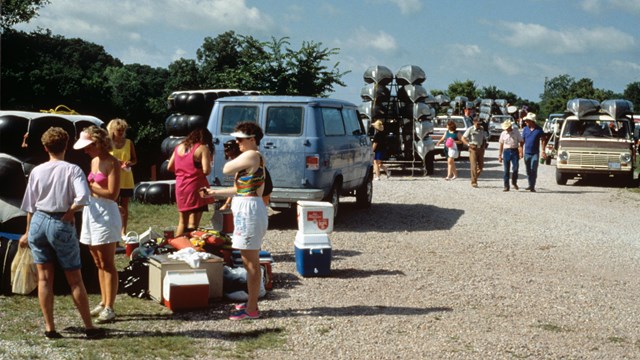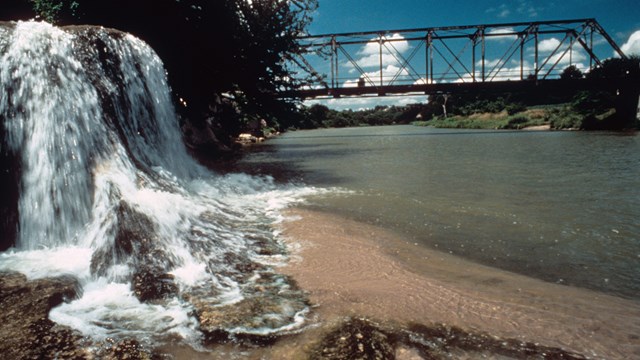Transcript
♫ [Music plays] ♫
NARRATOR: The cool running water of the Niobrara has attracted people to its shores since ancient times. In the Ponca language, “Niobrara” means running waters or wide-flowing waters. Traditionally, when we traveled and we moved camp, there had to be a lake, or a spring or a river that we would’ve camped near. So we were always around the water. Holes like this— if you’re hungry, that’s where you catch your fish at. This river here, we used it for traveling to village sites, trading goods, and along the river there are places where we gathered different food sources. NARRATOR: Pawnee, Lakota, and other tribes also hunted and traveled through the Niobrara River valley. Europeans arrived in the 1700s, exploring and trading with American Indian tribes. The population grew in the area when the US Army established one of the last frontier forts to be built on the Great Plains in 1879: Fort Niobrara. The arrival of the Fremont, Elkhorn and Missouri Valley Railroad in 1883 opened the area to homesteading and cattle ranching. RICH EGELHOFF: My great-great-grandfather came over from Germany. And then my great-grandfather came to Keya Paha County just north of here. The house that they built, they built out of rock and cement. NARRATOR: Valentine City supplied the Sandhill region’s ranchers and homesteaders through sun and snow. When troops departed, Fort Niobrara was established as a national wildlife refuge in 1912. The red hay barn is all that remains from the early days. MAN: There you go! Rope him. Good Job! NARRATOR: Today, Valentine is still a cattle town at heart. The ranching heritage is celebrated on Main Street at the annual Bull Bash. ROD GIERAU: My grandfather come over from the Alsace-Lorraine and homesteaded right where we’re at in 1884. We’re one of the very first homesteaders in Keya Paha County. NARRATOR: The human history of the Niobrara River valley is rich and continues to link those who live along it today with those who have come in the past. DENNY BAMMERLIN: Once your land’s been in the family for 100 years, you feel pretty obligated not to mess up. There’s… it’s a strong connection to the land. I feel the presence of my ancestors when I'm close to the areas where they would have camped or where they would have lived. And when I'm in certain areas Where I know they were, where they lived, I get goosebumps, because I can feel them there.
Visit our keyboard shortcuts docs for details
Explore the recent human history of the Niobrara River Valley, which makes the Niobrara such a unique and wonderful place. 
The Niobrara Council The early people of the Niobrara knew it as a sacred place where "Niobrara" - spreading water river- flowed freely and wildlife were abundant when the seasons made the river an ideal place for them to be. The Niobrara River Valley was first cared for by twenty-one roaming native american nations who knew the resources of the land and celebrated the river as a fruitful home during bison hunting seasons. When the Homestead Act of 1862 was signed into law by President Lincoln, settlers from the East and South moved in to claim 160 acres of land, driving Westward expansion and starting communities of diverse people in small settlements like Valentine, Brownlee, and DeWitty.There were contentious times as homesteaders set out to plot their homestead boundaries, raising fences and contending with nature to make the sandhills and five other ecosystems work in harmony and become prosperous while reservation systems were set up for the first caretakers of the Niobrara River Valley. The City of Valentine grew as a military fort was erected East of town called Fort Niobrara. Soldiers lived, worked, patrolled the river and countryside, aiding in the industrialization and permanent settlement of the Niobrara River Valley by pioneers and homesteaders. This era, during the Plains Indian Wars, expanded the population of the region and communities became more established as did the industry of the area, farming and ranching. For many years, Valentine and the Niobrara River were a stop along the way for travelers heading North, West, and South to further regions of the country, but those who stayed managed cattle ranches, grew crops in the sandy soil, and found what they had hoped for when they set out to settle the unknown regions of the United States. While agriculture and cattle ranching still make up the majority of the industry along the Niobrara River, the gentle waters and scenic views drummed up another source of income for the adventurous of heart in the 1970s and 1980s. The Niobrara River began to offer recreational opportunities and sights that most midwesterners would be hard-pressed to find elsewhere in the Midwest. Waterfalls and tubing trips made for afternoon outings. Campgrounds and river trips offered leisure time for families and people of all ages and abilities to explore without having to travel to the far West or crossover mountain ranges. Smith Falls, the tallest waterfalls in Nebraska, along the Niobrara River, was cared for by a family who saw reason to make its beauty available to the public and still protect it for years to come. Now visitors and locals alike float the Niobrara River on tubes, canoes, kayaks, and paddleboards. Outfitting business for renting equipment flourish alongside ranches and farms, and families still enjoy the sacred beauty and scenery that has been cared for by so many different people of the Niobrara River through time. 
People of the Niobrara
Hear the Stories of those who Know the Water Best 
Places on the Niobrara
Where has the River flowed for so many years, and what stories has it heard at each place? |
Last updated: February 5, 2021
